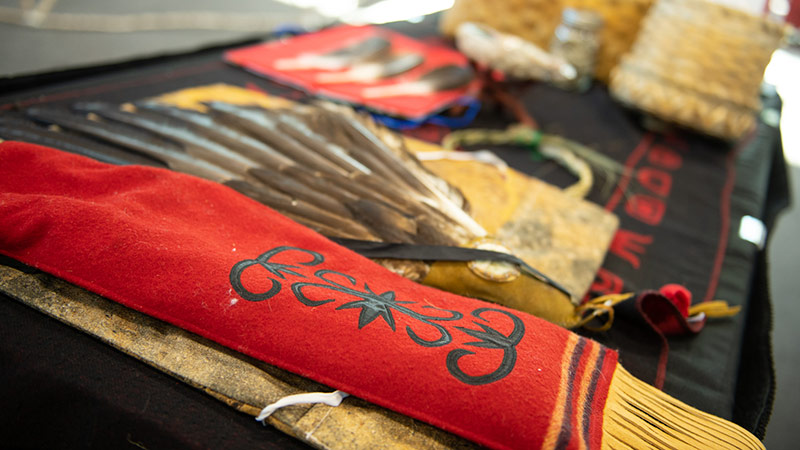Cheyenne Joseph on the cultural practices of the National Day for Truth and Reconciliation ceremony
Author: Angie Deveau
Posted on Sep 28, 2023
Category: UNB Fredericton , UNB Saint John

To honour residential school survivors and remember the children who did not return home, the University of New Brunswick (UNB) will host a National Truth and Reconciliation Day ceremony on Sept. 30.
This commemorative event will take place on the Fredericton campus and livestream on the Saint John campus.
As we approach the third year of this ceremony, there remains a need for understanding and respect regarding cultural practices around ceremonies like this. Cheyenne Joseph, UNB’s newly appointed Piluwitahasuwin sat down with us to discuss how non-Indigenous people can authentically learn and participate.
What can attendees expect at the Sept. 30 event at UNB?
Attendees can expect to hear from survivors, witness cultural ceremonies such as drumming, singing, chanting, and dancing and engage in storytelling. The event provides an opportunity to learn from Elders and Survivors, as oral tradition is a key means of sharing knowledge in Indigenous culture.
Tell us about oral tradition and why it’s important?
The oral tradition is a deeply rooted and culturally significant practice that involves the sharing of knowledge, stories, history, and cultural values through spoken words, storytelling, songs and ceremony within a community. It has a rich historical significance, serving as the primary means of passing down information long before the advent of written language and recorded history.
Elders and community members serve as storytellers, sharing narratives that range from creation stories to sacred teachings to community histories. When engaging with the oral tradition of Indigenous cultures or any community, it is crucial to approach it with respect, honour and cultural sensitivity. This includes understanding the cultural contexts of this practice and recognizing the significance of these traditions in maintaining cultural identity and continuity.
Why is saying "I'm sorry" significant in the context of the National Day for Truth and Reconciliation?
The significance lies in acknowledging Indigenous communities' historical injustices, especially in residential schools. It serves as a reminder of our commitment to never repeat this history and to respond to the TRC's calls to action.
How do these events relate to the TRC calls to action and why are they critical for recognizing and commemorating residential schools' history?
The events align with the TRC's calls to action to acknowledge the truth and promote reconciliation. Recognizing and commemorating residential schools' history is essential to understanding both Indigenous and Canadian perspectives, fostering understanding and healing.
The National Day for Truth and Reconciliation is also Orange Shirt Day. Why do we wear orange shirts on this day?
Orange Shirt Day is inspired by Phyllis Webstad, a member of the Stwecem’c Xgat’tem First Nation. Six-year-old Phyllis wore her new orange shirt to St. Joseph's residential school in Williams Lake, BC, on her first day in 1973. When she arrived at school, her hair was cut and her orange shirt was taken. That was the last time she saw that shirt. Phyllis' story represents children's experiences at residential schools across Canada. When we wear orange shirts, we remember.
What is an Honour Song?
An Honour song is a nation's anthem. It honours who we are, respecting and identifying the people. It is typically sung at the beginning of an event or gathering and all in attendance are asked to stand while it's being sung. On Sept. 30, participants will hear both the Wolastoq and Mi’kmaw Honour songs.
What is smudging?
Smudging is traditionally a ceremony for purifying or cleansing oneself or a space of negative energy person. The following four elements of life can be seen in a smudge:
- A shell holds the smudge, representing the first element of life - water.
- Four spiritually sacred medicines (tobacco, sage, cedar, sweetgrass) represent the second element of life - earth.
- Fire is produced from lighting medicines, representing the third element - fire.
- The smoke produced by the fire represents the fourth element of life - air.
There is no “right way” to smudge, but there are common practices.
What lessons should non-Indigenous people take away from the National Day for Truth and Reconciliation?
Non-Indigenous people should be conscious of what they've learned during the event and consider how they can actively contribute to the next chapter of Canada's history. This includes creating inclusive spaces and being aware of unconscious biases. This ensures that Indigenous ways of knowing, being and doing are respected without devaluing other perspectives.
What can people do every day to commemorate and contribute to truth and reconciliation?
Individuals can integrate truth and reconciliation into their daily lives by ensuring Indigenous perspectives are part of everyday conversations and actions. This involves being conscious consumers when purchasing orange shirts, supporting Indigenous-owned businesses and amplifying Indigenous voices rather than leading the work.
Learn more or access support.
